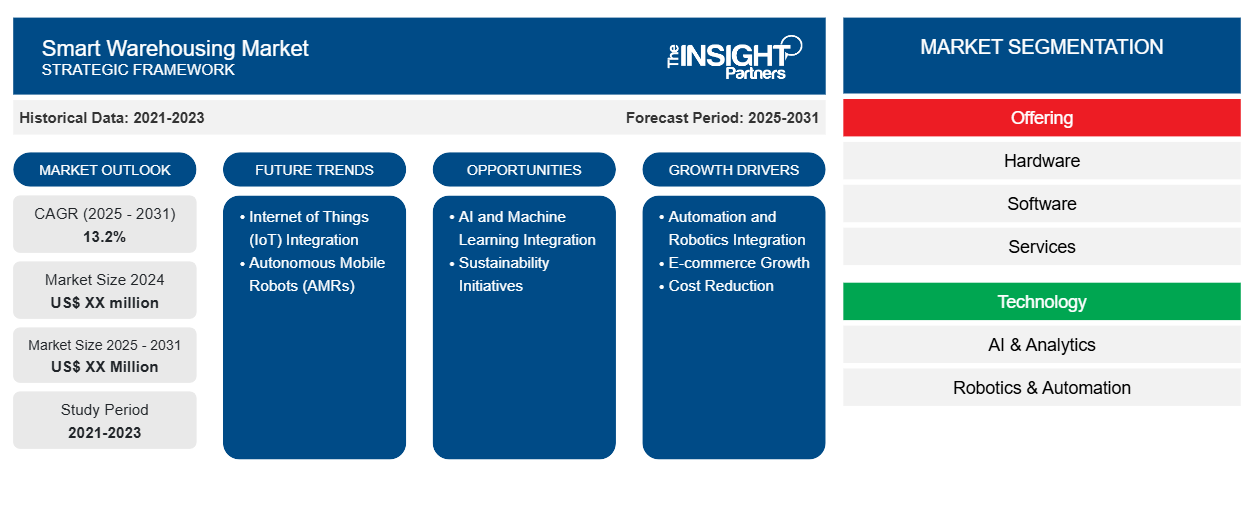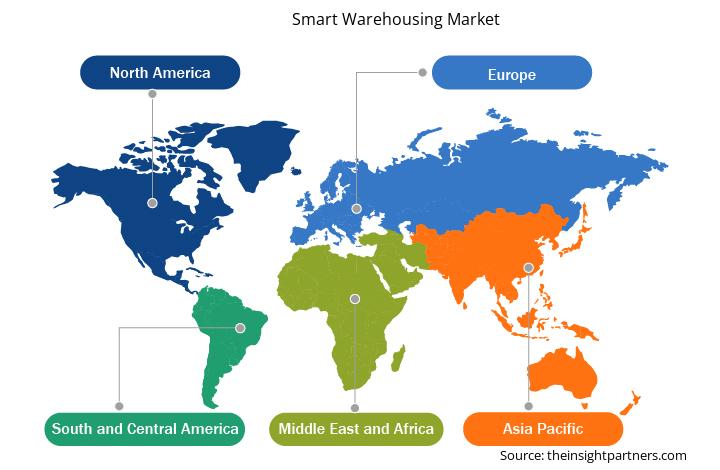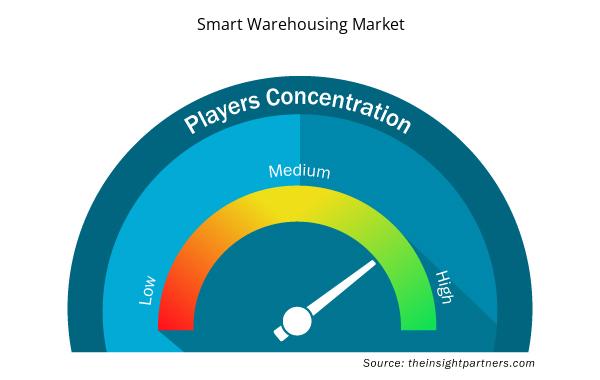Si prevede che il mercato dello Smart Warehousing registrerà un CAGR del 13,2% dal 2025 al 2031, con una dimensione del mercato in espansione da XX milioni di dollari nel 2024 a XX milioni di dollari entro il 2031.
Il report è segmentato per Offerta (Hardware, Software, Servizi), Tecnologia (IA e Analisi, Robotica e Automazione), Applicazione (Gestione dell'Inventario, Analisi Predittiva). L'analisi globale è ulteriormente suddivisa a livello regionale e per i principali Paesi. Il report fornisce il valore in USD per le analisi e i segmenti sopra indicati.
Scopo del rapporto
Il rapporto "Smart Warehousing Market" di The Insight Partners mira a descrivere il panorama attuale e la crescita futura, i principali fattori trainanti, le sfide e le opportunità. Questo fornirà spunti di riflessione a diversi stakeholder aziendali, tra cui:
- Fornitori/produttori di tecnologia: per comprendere le dinamiche di mercato in evoluzione e conoscere le potenziali opportunità di crescita, consentendo loro di prendere decisioni strategiche informate.
- Investitori: condurre un'analisi completa delle tendenze in merito al tasso di crescita del mercato, alle proiezioni finanziarie del mercato e alle opportunità esistenti lungo la catena del valore.
- Enti di regolamentazione: regolamentano le politiche e le attività di polizia nel mercato allo scopo di ridurre al minimo gli abusi, preservare la fiducia degli investitori e sostenere l'integrità e la stabilità del mercato.
Segmentazione del mercato dell'immagazzinamento intelligente
Offerta
- Hardware
- Software
- Servizi
Tecnologia
- IA e analisi
- Robotica e automazione
Applicazione
- Gestione dell'inventario
- Analisi predittiva
Geografia
- America del Nord
- Europa
- Asia Pacifico
- Medio Oriente e Africa
- America meridionale e centrale
Personalizza questo report in base alle tue esigenze
Riceverai la personalizzazione gratuita di qualsiasi report, incluse parti di questo report, analisi a livello nazionale, pacchetto dati Excel e potrai usufruire di fantastiche offerte e sconti per start-up e università.
Mercato dell'immagazzinamento intelligente: approfondimenti strategici

- Scopri le principali tendenze di mercato di questo rapporto.Questo campione GRATUITO includerà analisi di dati che spaziano dalle tendenze di mercato alle stime e alle previsioni.
Fattori di crescita del mercato dell'immagazzinamento intelligente
- Integrazione tra automazione e robotica: la crescente adozione dell'automazione, come la robotica e i sistemi di trasporto, migliora l'efficienza operativa, riduce l'errore umano e velocizza i processi. Questi progressi sono cruciali per gestire inventari complessi e soddisfare la crescente domanda di evasione degli ordini rapida e accurata in settori come l'e-commerce e la vendita al dettaglio.
- Crescita dell'e-commerce: l'impennata dell'e-commerce ha creato la domanda di una logistica più rapida ed efficiente. Le tecnologie di magazzino intelligenti, come i sistemi di stoccaggio/recupero automatizzati, ottimizzano lo spazio di stoccaggio e riducono i tempi di prelievo, consentendo alle aziende di tenere il passo con la crescente domanda di consegne rapide da parte dei consumatori.
- Riduzione dei costi: i magazzini intelligenti utilizzano tecnologie avanzate come IoT e intelligenza artificiale per semplificare le operazioni, ridurre al minimo gli sprechi e ridurre i costi operativi. Ciò include risparmi energetici, ottimizzazione dell'utilizzo della manodopera e una migliore gestione delle risorse, aiutando le aziende ad aumentare la redditività in mercati competitivi con margini ridotti.
Tendenze future del mercato dell'immagazzinamento intelligente
- Integrazione con l'Internet of Things (IoT): l'utilizzo di dispositivi IoT nei magazzini intelligenti è in aumento, offrendo tracciamento in tempo reale, monitoraggio remoto e manutenzione predittiva delle apparecchiature. L'IoT consente operazioni connesse, offrendo informazioni più approfondite sui livelli di inventario, sulle condizioni di stoccaggio e sulle prestazioni operative, migliorando così l'efficienza e riducendo i tempi di inattività.
- Robot mobili autonomi (AMR): i robot mobili autonomi (AMR) stanno diventando sempre più diffusi nei magazzini intelligenti, supportando attività come il prelievo degli ordini, il trasporto delle scorte e la scansione degli scaffali. Questi robot sono sempre più utilizzati per migliorare la flessibilità e ridurre il lavoro umano, migliorando la velocità e la precisione complessive delle operazioni di magazzino.
Opportunità di mercato per l'immagazzinamento intelligente
- Integrazione tra intelligenza artificiale e apprendimento automatico: l'intelligenza artificiale e l'apprendimento automatico stanno aprendo nuove opportunità per sistemi di magazzino più intelligenti, in grado di prevedere la domanda, ottimizzare la gestione dell'inventario e migliorare il processo decisionale. Queste tecnologie migliorano l'accuratezza delle previsioni e consentono ai magazzini di adattarsi meglio alle mutevoli dinamiche di mercato, migliorando ulteriormente l'efficienza operativa.
- Iniziative per la sostenibilità: con la crescente consapevolezza ambientale, le pratiche sostenibili stanno diventando una priorità. I magazzini intelligenti possono implementare sistemi a risparmio energetico, ridurre gli sprechi attraverso una migliore gestione dell'inventario e integrare fonti di energia rinnovabili, tutte opportunità per raggiungere gli obiettivi di sostenibilità e attrarre consumatori attenti all'ambiente.
Approfondimenti regionali sul mercato dell'immagazzinamento intelligente
Le tendenze e i fattori regionali che influenzano il mercato dello Smart Warehousing durante il periodo di previsione sono stati ampiamente illustrati dagli analisti di Insight Partners. Questa sezione illustra anche i segmenti e la geografia del mercato dello Smart Warehousing in Nord America, Europa, Asia-Pacifico, Medio Oriente e Africa, e Sud e Centro America.

- Ottieni i dati specifici regionali per il mercato dell'immagazzinamento intelligente
Ambito del rapporto di mercato sull'immagazzinamento intelligente
| Attributo del report | Dettagli |
|---|---|
| Dimensioni del mercato nel 2024 | XX milioni di dollari USA |
| Dimensioni del mercato entro il 2031 | XX milioni di dollari USA |
| CAGR globale (2025-2031) | 13,2% |
| Dati storici | 2021-2023 |
| Periodo di previsione | 2025-2031 |
| Segmenti coperti | Offrendo
|
| Regioni e paesi coperti | America del Nord
|
| Leader di mercato e profili aziendali chiave |
|
Densità degli operatori del mercato dello Smart Warehousing: comprendere il suo impatto sulle dinamiche aziendali
Il mercato dello Smart Warehousing è in rapida crescita, trainato dalla crescente domanda degli utenti finali, dovuta a fattori quali l'evoluzione delle preferenze dei consumatori, i progressi tecnologici e una maggiore consapevolezza dei vantaggi del prodotto. Con l'aumento della domanda, le aziende stanno ampliando la propria offerta, innovando per soddisfare le esigenze dei consumatori e capitalizzando sui trend emergenti, alimentando ulteriormente la crescita del mercato.
La densità degli operatori di mercato si riferisce alla distribuzione delle imprese che operano in un determinato mercato o settore. Indica quanti concorrenti (operatori di mercato) sono presenti in un determinato spazio di mercato in relazione alle sue dimensioni o al suo valore totale.
Le principali aziende che operano nel mercato dello Smart Warehousing sono:
- Manhattan Associates
- Korber
- Oracolo
- LINFA
- Tecsys
- PSI Logistics
Disclaimer : le aziende elencate sopra non sono classificate secondo alcun ordine particolare.

- Ottieni una panoramica dei principali attori del mercato dello Smart Warehousing
Punti di forza chiave
- Copertura completa: il rapporto affronta in modo esaustivo l'analisi dei prodotti, dei servizi, delle tipologie e degli utenti finali del mercato dello Smart Warehousing, fornendo una panoramica olistica.
- Analisi degli esperti: il rapporto è compilato sulla base della conoscenza approfondita di esperti e analisti del settore.
- Informazioni aggiornate: il rapporto garantisce la pertinenza aziendale grazie alla copertura di informazioni recenti e tendenze nei dati.
- Opzioni di personalizzazione: questo report può essere personalizzato per soddisfare le esigenze specifiche del cliente e adattarsi in modo appropriato alle strategie aziendali.
Il rapporto di ricerca sul mercato dello Smart Warehousing può quindi contribuire a tracciare un percorso di decodificazione e comprensione dello scenario del settore e delle prospettive di crescita. Sebbene possano esserci alcune valide preoccupazioni, i vantaggi complessivi di questo rapporto tendono a superare gli svantaggi.
- Analisi storica (2 anni), anno base, previsione (7 anni) con CAGR
- Analisi PEST e SWOT
- Valore/volume delle dimensioni del mercato - Globale, regionale, nazionale
- Industria e panorama competitivo
- Set di dati Excel



Report Coverage
Revenue forecast, Company Analysis, Industry landscape, Growth factors, and Trends

Segment Covered
This text is related
to segments covered.

Regional Scope
North America, Europe, Asia Pacific, Middle East & Africa, South & Central America

Country Scope
This text is related
to country scope.
Domande frequenti
The report can be delivered in PDF/PPT format; we can also share excel dataset based on the request
Automation and Robotics Integration, E-commerce Growth
Internet of Things (IoT) Integration, Autonomous Mobile Robots (AMRs)
Some of the customization options available based on the request are an additional 3–5 company profiles and country-specific analysis of 3–5 countries of your choice. Customizations are to be requested/discussed before making final order confirmation# as our team would review the same and check the feasibility
The global Smart Warehousing market is expected to grow at a CAGR of 13.2% during the forecast period 2024 - 2031
Trends and growth analysis reports related to Electronics and Semiconductor : READ MORE..
The Insight Partners performs research in 4 major stages: Data Collection & Secondary Research, Primary Research, Data Analysis and Data Triangulation & Final Review.
- Data Collection and Secondary Research:
As a market research and consulting firm operating from a decade, we have published and advised several client across the globe. First step for any study will start with an assessment of currently available data and insights from existing reports. Further, historical and current market information is collected from Investor Presentations, Annual Reports, SEC Filings, etc., and other information related to company’s performance and market positioning are gathered from Paid Databases (Factiva, Hoovers, and Reuters) and various other publications available in public domain.
Several associations trade associates, technical forums, institutes, societies and organization are accessed to gain technical as well as market related insights through their publications such as research papers, blogs and press releases related to the studies are referred to get cues about the market. Further, white papers, journals, magazines, and other news articles published in last 3 years are scrutinized and analyzed to understand the current market trends.
- Primary Research:
The primarily interview analysis comprise of data obtained from industry participants interview and answers to survey questions gathered by in-house primary team.
For primary research, interviews are conducted with industry experts/CEOs/Marketing Managers/VPs/Subject Matter Experts from both demand and supply side to get a 360-degree view of the market. The primary team conducts several interviews based on the complexity of the markets to understand the various market trends and dynamics which makes research more credible and precise.
A typical research interview fulfils the following functions:
- Provides first-hand information on the market size, market trends, growth trends, competitive landscape, and outlook
- Validates and strengthens in-house secondary research findings
- Develops the analysis team’s expertise and market understanding
Primary research involves email interactions and telephone interviews for each market, category, segment, and sub-segment across geographies. The participants who typically take part in such a process include, but are not limited to:
- Industry participants: VPs, business development managers, market intelligence managers and national sales managers
- Outside experts: Valuation experts, research analysts and key opinion leaders specializing in the electronics and semiconductor industry.
Below is the breakup of our primary respondents by company, designation, and region:

Once we receive the confirmation from primary research sources or primary respondents, we finalize the base year market estimation and forecast the data as per the macroeconomic and microeconomic factors assessed during data collection.
- Data Analysis:
Once data is validated through both secondary as well as primary respondents, we finalize the market estimations by hypothesis formulation and factor analysis at regional and country level.
- Macro-Economic Factor Analysis:
We analyse macroeconomic indicators such the gross domestic product (GDP), increase in the demand for goods and services across industries, technological advancement, regional economic growth, governmental policies, the influence of COVID-19, PEST analysis, and other aspects. This analysis aids in setting benchmarks for various nations/regions and approximating market splits. Additionally, the general trend of the aforementioned components aid in determining the market's development possibilities.
- Country Level Data:
Various factors that are especially aligned to the country are taken into account to determine the market size for a certain area and country, including the presence of vendors, such as headquarters and offices, the country's GDP, demand patterns, and industry growth. To comprehend the market dynamics for the nation, a number of growth variables, inhibitors, application areas, and current market trends are researched. The aforementioned elements aid in determining the country's overall market's growth potential.
- Company Profile:
The “Table of Contents” is formulated by listing and analyzing more than 25 - 30 companies operating in the market ecosystem across geographies. However, we profile only 10 companies as a standard practice in our syndicate reports. These 10 companies comprise leading, emerging, and regional players. Nonetheless, our analysis is not restricted to the 10 listed companies, we also analyze other companies present in the market to develop a holistic view and understand the prevailing trends. The “Company Profiles” section in the report covers key facts, business description, products & services, financial information, SWOT analysis, and key developments. The financial information presented is extracted from the annual reports and official documents of the publicly listed companies. Upon collecting the information for the sections of respective companies, we verify them via various primary sources and then compile the data in respective company profiles. The company level information helps us in deriving the base number as well as in forecasting the market size.
- Developing Base Number:
Aggregation of sales statistics (2020-2022) and macro-economic factor, and other secondary and primary research insights are utilized to arrive at base number and related market shares for 2022. The data gaps are identified in this step and relevant market data is analyzed, collected from paid primary interviews or databases. On finalizing the base year market size, forecasts are developed on the basis of macro-economic, industry and market growth factors and company level analysis.
- Data Triangulation and Final Review:
The market findings and base year market size calculations are validated from supply as well as demand side. Demand side validations are based on macro-economic factor analysis and benchmarks for respective regions and countries. In case of supply side validations, revenues of major companies are estimated (in case not available) based on industry benchmark, approximate number of employees, product portfolio, and primary interviews revenues are gathered. Further revenue from target product/service segment is assessed to avoid overshooting of market statistics. In case of heavy deviations between supply and demand side values, all thes steps are repeated to achieve synchronization.
We follow an iterative model, wherein we share our research findings with Subject Matter Experts (SME’s) and Key Opinion Leaders (KOLs) until consensus view of the market is not formulated – this model negates any drastic deviation in the opinions of experts. Only validated and universally acceptable research findings are quoted in our reports.
We have important check points that we use to validate our research findings – which we call – data triangulation, where we validate the information, we generate from secondary sources with primary interviews and then we re-validate with our internal data bases and Subject matter experts. This comprehensive model enables us to deliver high quality, reliable data in shortest possible time.

 Ottieni un campione gratuito per questo repot
Ottieni un campione gratuito per questo repot